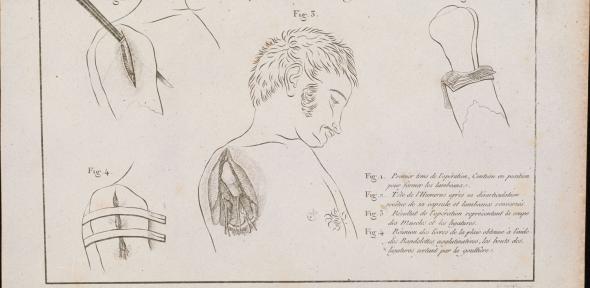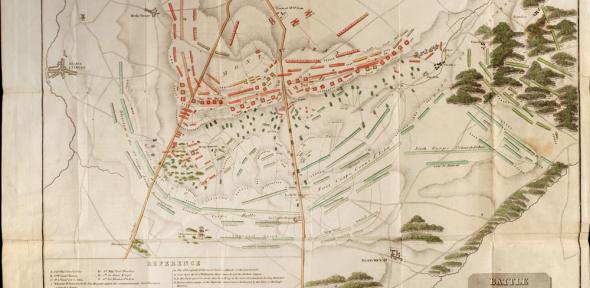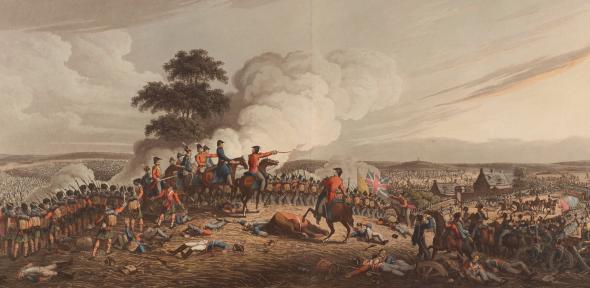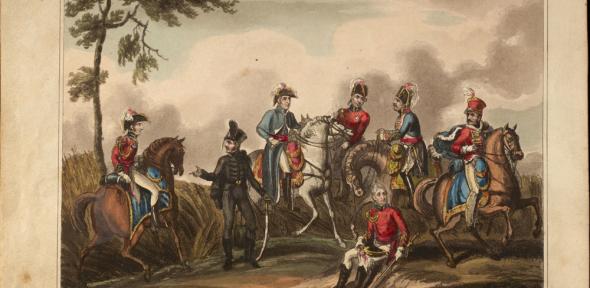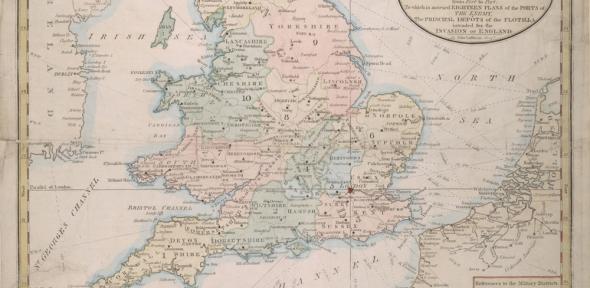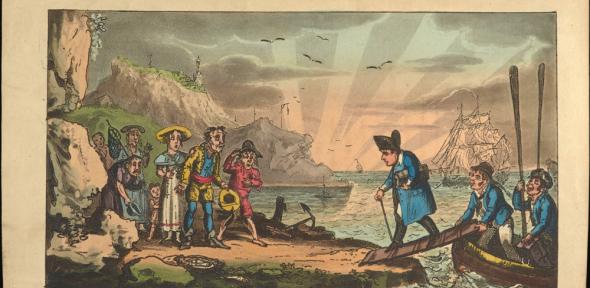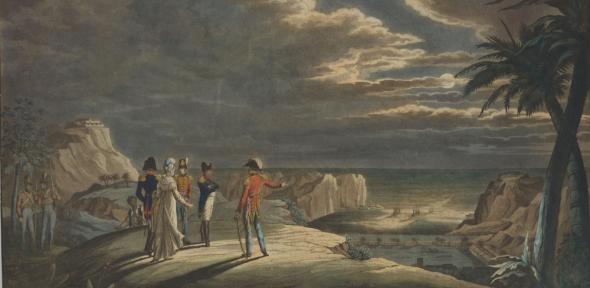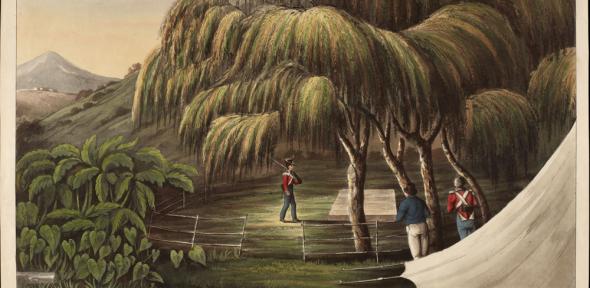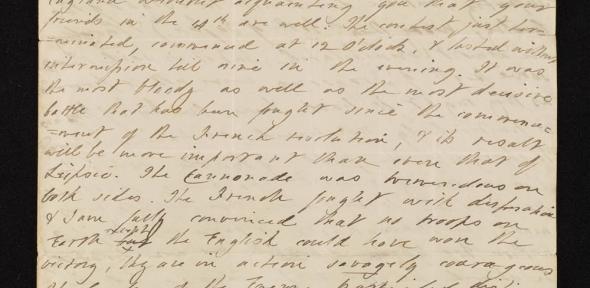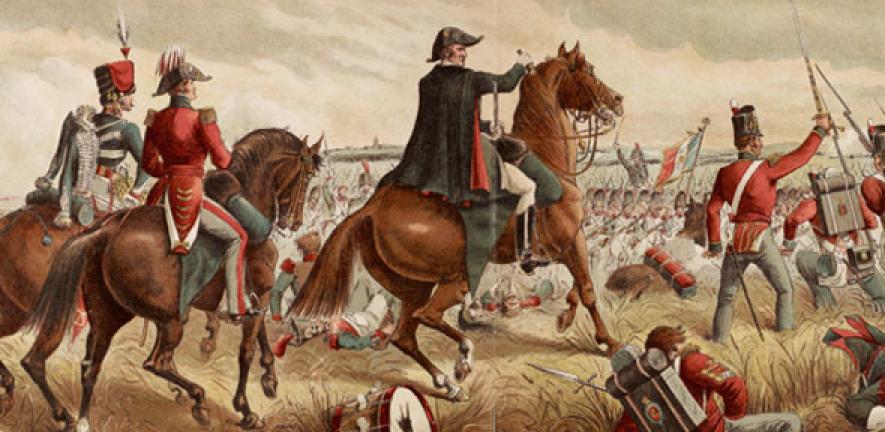
A letter written from the body-strewn battlefield at Waterloo, an invasion map of the UK, and a book from Napoleon’s personal library in exile will go on display in Cambridge during one of the first major Waterloo exhibitions of the bicentenary commemorations.
A letter written from the body-strewn battlefield at Waterloo, an invasion map of the UK, and a book from Napoleon’s personal library in exile will go on display in Cambridge during one of the first major Waterloo exhibitions of the bicentenary commemorations.
Waterloo is the most famous battle in modern European history, and from the very first moment soldiers and civilians alike wanted to put their experiences and emotions into words.
John Wells
A Damned Serious Business: Waterloo 1815, the Battle and its Books, will be launched by the current Duke of Wellington, Charles Wellesley, at Cambridge University Library tonight and opens to the public on May 1. The exhibition runs until September 16, 2015.
Looking at how Waterloo was written about in the immediate aftermath of the battle fought on June 18, 1815, it draws on the rich and varied collections at the Library and includes political propaganda, broadsheets, military drill-books, maps, plans, coloured engravings and early historical accounts of the bloodshed.
Historian Dr Mark Nicholls, who has co-curated the exhibition, said: “The exhibition really shows us the first draft of history as it was being written in the days, months and years after the battle.
“When Waterloo is talked about today, there is sometimes a tendency to view the battle as strictly France versus Britain; Napoleon versus Wellington. What the Library’s exhibition reminds us is that the armies opposing Napoleon were very much a combined force of Allied troops – chiefly British, Netherlandish and Hanoverian, commanded by Wellington, and Prussians led by Blücher.”
The exhibition also features artefacts and mementoes from the battlefield itself, including a musket ball and a charred fragment of Hougoumont, the farmhouse which occupied a vital position in Wellington’s line. The relics were collected by a teenaged girl visiting the field ten years after the battle.
Other items that have never been on display before include a letter from the traveller William Crackanthorpe to his sister Sarah in August, 1814, giving a first-hand account of a conversation with Napoleon in exile on Elba; and William Turnor’s battlefield letter from Mont St Jean on June 19, 1815 (see attached transcript).
The letter, which has never been published in full, describes the exhilaration, confusion and savagery of ‘the most bloody as well as the most decisive battle’ and claims that the British infantry has ‘immortalised itself and its conduct has never been surpassed, indeed never equalled’. Although his own regiment, stationed on the right of the line, was spared the fiercest fighting, Turnor passes on rumour and gossip in an authentically breathless style.
“The field of Battle exhibits this morning a most shocking spectacle too dreadful to describe. Buonaparte (sic)…showed the greatest courage; led in person many charges both of infantry & cavalry. The escape of Lord Wellington is next to a miracle, for he was exposed the whole day to the hottest fire. We know not the extent of our loss, but it must be great indeed.”
Exhibition Co-Curator John Wells said: “The importance of Waterloo was fully recognised by the generations which came after it. Both Byron and Tennyson wrote of Waterloo as an ‘earthquake’. Victor Hugo said that the battle changed the perspective of the human race.
“Waterloo is the most famous battle in modern European history, and from the very first moment soldiers and civilians alike wanted to put their experiences and emotions into words. In this exhibition we examine how the battle’s impact was expressed through the written word, and how the documentary records of the time continue to have resonance for us today. Waterloo is still news, two hundred years later.”
The exhibits on display in Cambridge will illuminate how historical accounts of the campaign proliferated within months of the battle as Waterloo was assimilated into popular culture, becoming the subject of poems, novels, works of visual art and even comic entertainments.
Part of the wider Waterloo 200 commemorations, A Damned Serious Business also charts the build-up to the battle and its aftermath, following the journey from a Europe in turmoil to Waterloo becoming a tourist destination, a legacy which remains to this day.
Cartoons and a spoof theatrical poster illustrate popular defiance in Britain in the face of a threatened French invasion, while an infantry drill-book shows how the Army went about training its soldiers to defeat Napoleon. Large-scale volumes illustrated in full colour and published in the years straight after the battle show how the victory was celebrated in Britain through the medium of the book. The poignant memoir of Lady De Lancey highlights the appalling personal cost of the fighting.
Alongside Napoleon’s own copy of Montaigne’s Essais – from his library in exile on St Helena – the exhibition also features an 1834 letter from the Duke of Wellington in which he agrees to present a petition to the House of Lords from Cambridge undergraduates, as well as a wonderful fold-out, full colour representation of the Duke’s funeral procession in 1852. The fold-out measures more than 20 metres in length and contains a cast of thousands.

The text in this work is licensed under a Creative Commons Attribution 4.0 International License. For image use please see separate credits above.

